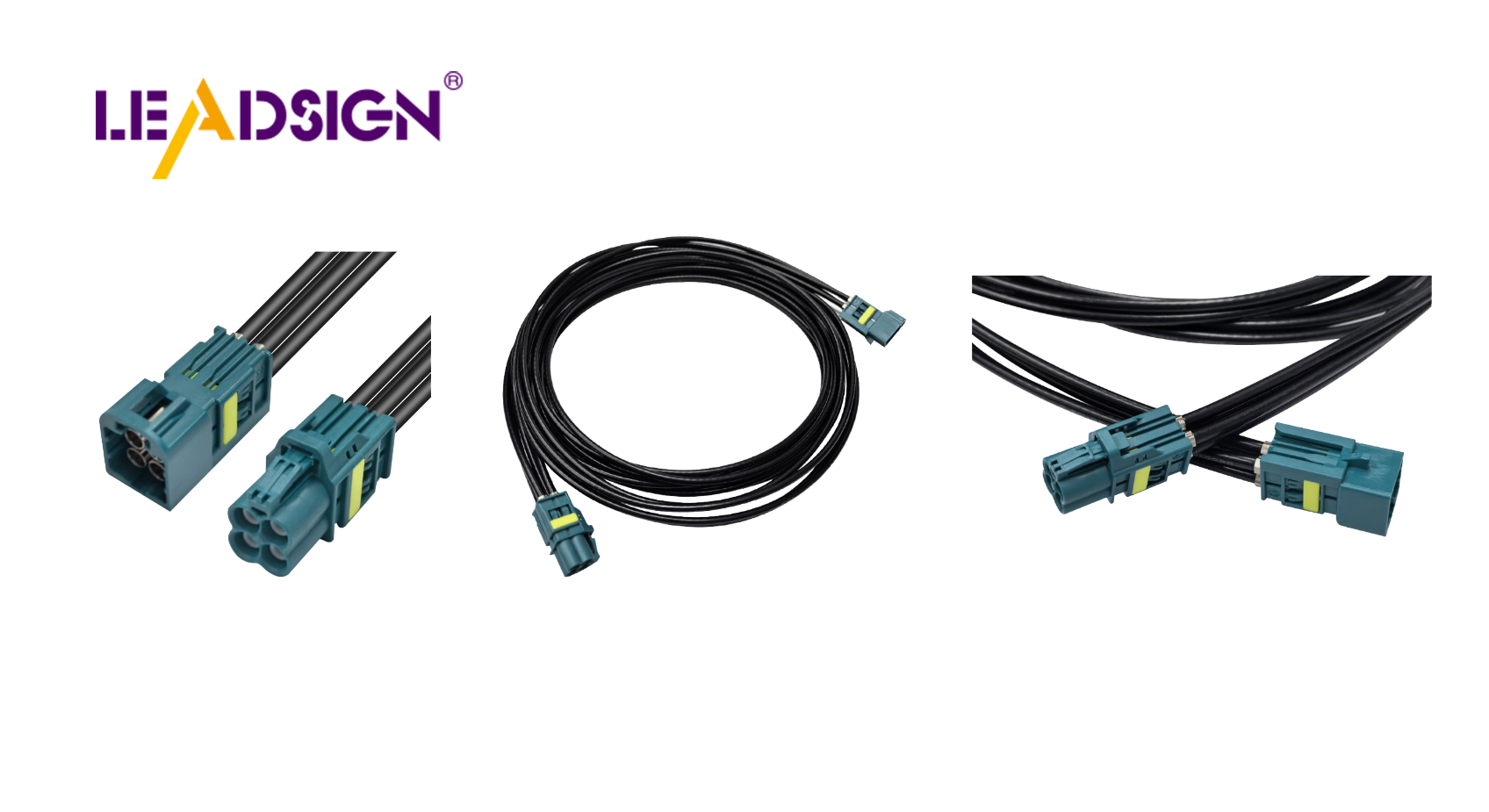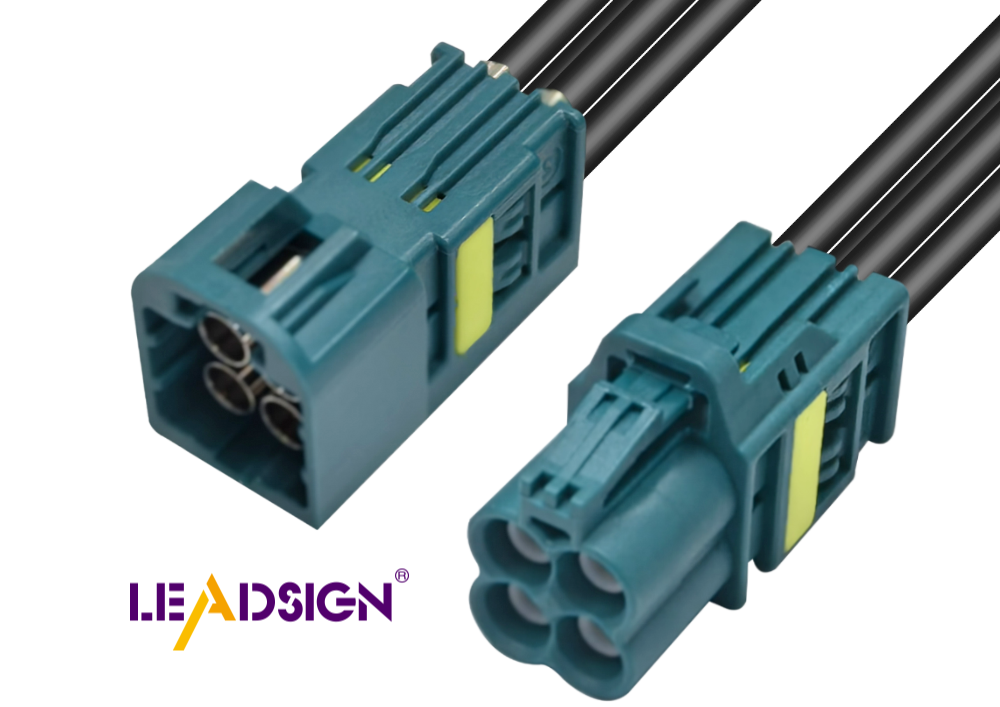How to Distinguish Male and Female Automotive Plugs and Connectors

When using automotive plugs and connectors, knowing their types is important. Male connectors have pins that go into female connector holes. It's like a key fitting into a lock—they match perfectly. This design helps them line up right and carry electricity. Remember this: male connectors "go into" female connectors, which "take in" the connection. This easy system keeps your connections safe and working well.
Key Takeaways
Understand the basic difference: Male connectors have pins that fit into female connectors' sockets, ensuring a secure electrical connection.
Pay attention to physical traits: Male connectors are typically smaller and pointy, while female connectors are wider and designed to hold the pins securely.
Use color and material clues: Colors like red indicate positive connections, while black or blue signify negative. High-quality materials ensure durability and reliability.
Familiarize yourself with common connector types: Blade, bullet, and multi-pin connectors each serve specific functions and have unique designs.
Utilize diagrams and multimeters: Connector diagrams help identify types accurately, while a multimeter can test the performance of connectors to ensure they are functioning properly.
Avoid common mistakes: Always check connector types carefully, avoid forcing connections, and read labels to prevent mismatches and potential damage.
Regular maintenance is key: Inspect connectors regularly for wear and tear, especially weatherproof types, to ensure your vehicle's electrical system remains safe and efficient.
Physical Traits of Male and Female Automotive Plugs and Connectors
Knowing the physical traits of automotive plugs helps you spot them easily. Let’s look at three main points: pin and socket setups, shape differences, and material or color clues.
Pin and Socket Setups
The biggest difference is in their pin and socket design. Male connectors have pins that stick out to make the connection. These pins fit tightly into female sockets, which are made to hold them. This setup makes sure electricity flows safely.
Look closely at how many pins or sockets there are. For example:
Single-pin connectors work for simple circuits.
Multi-pin connectors handle complex systems like modern cars.
Pins need to line up correctly with sockets. If not, it may cause problems or damage. Always check before connecting.
Shape Differences
The shapes of automotive plugs also help tell them apart. Male plugs are smaller and pointy, while female ones are wider to hold the pins. Some are round; others are square or unique to avoid mistakes.
Manufacturers design shapes for specific uses. For example:
Blade connectors are flat for quick use.
Bullet connectors are round for a tight fit.
Weatherproof connectors have seals to block water or dirt.
By checking the shape, you can figure out its purpose.
Material and Color Clues
Materials and colors give more hints about automotive plugs. Good-quality ones use strong plastic or metal to last longer under tough conditions. Weatherproof types may add rubber seals for extra protection.
Colors also help identify function or polarity quickly. For instance:
Red shows a positive connection.
Black or blue means negative or ground connection.
These features make it easier to pick the right connector without mistakes. Always check materials and colors before using them.
Pro Tip: Use high-quality options like OEM-grade ones for safety in your car's system. Regular checks keep them working well longer!
Common Types of Automotive Plugs and Connectors

Knowing the types of automotive plugs helps pick the right one. Each type has special features for specific uses. Let’s look at three common ones: blade, bullet, and multi-pin connectors.
Blade Connectors
Blade connectors are very popular in car systems. They have a flat metal piece that fits into a slot. This design keeps the connection strong and secure. You’ll see them in fuse boxes or wiring setups.
Key Features:
Slim shape saves space.
Easy to use without tools.
Best for low-voltage tasks.
They come in sizes like Micro Blade or Beam 0.40 mm types. These small designs save space in modern cars with tight areas. Make sure the blade fits well to keep electricity flowing.
Tip: Don’t force a blade connector into the wrong slot—it can break.
Bullet Connectors
Bullet connectors are round and shaped like a cylinder. They include a male pin and female socket that fit tightly together. This makes them great for places with lots of movement or shaking.
Key Features:
Winged tabs make setup simple.
Twist-on versions connect wires fast.
Strong design stays secure during motion.
These are used in motorcycles, trailers, or moving vehicles. Be careful when twisting wires too much; it may harm them.
Pro Tip: Check old bullet connectors for rust or damage often to avoid problems.
Multi-Pin Connectors
Multi-pin connectors work well for complex car systems. They have many pins inside a tough shell to keep connections safe and neat. You’ll find these in modern cars handling advanced tech like screens or safety aids.
Key Features:
Many pins send power or data across circuits.
Hard shells protect against damage.
Built to stay connected even under tough conditions.
Some have springs inside to hold pins steady during vibrations or movement. These connectors are key for high-tech car parts working properly.
Did You Know? Multi-pin connectors go through strict tests to ensure they work perfectly under stress.
By learning about these three connector types, you can choose wisely when fixing your vehicle. Each type has its job, so picking correctly ensures safety and good performance.
Weatherproof Connectors
Weatherproof connectors are important for cars in tough conditions. They keep water, dirt, and heat away from electrical parts. You’ll see them under car hoods or outdoors where strength is needed.
Key Features of Weatherproof Connectors:
Sealed Design: Rubber or silicone seals block moisture and dirt.
Durable Materials: Strong plastic or metal lasts a long time.
Locking Mechanisms: Clips or latches hold connections steady during movement.
These connectors come in many shapes and sizes for different uses. Some are round for small spaces; others are rectangular for bigger setups. Their strong build ensures they work well even in hard environments.
Pro Tip: Check the seals often on weatherproof connectors. Broken seals can ruin the connection.
High-Speed FAKRA-Mini Connectors
High-Speed FAKRA-Mini connectors are changing modern car systems. These connectors send data fast, perfect for advanced vehicle tech. Their small size saves space while still working great.
Features and Benefits
FAKRA-Mini connectors have features that make them ideal for new cars:
High Data Rates: They transfer data up to 28 Gbps quickly.
Compact Design: Small size saves 80% more space than older types.
Robust Build: With 50 Ω impedance, they work reliably up to 20 GHz.
Versatile Options: Available as straight, right-angle, or PCB connectors.
These features make FAKRA-Mini connectors a smart choice for modern vehicles.
Applications in Modern Vehicles
FAKRA-Mini connectors are used in high-tech car systems. They send data fast and reliably, making them key for:
Autonomous Driving: Helping cameras and sensors guide self-driving cars.
Driver Assistance Systems: Improving safety tools like lane assist and collision alerts.
Navigation and Infotainment: Providing smooth GPS and entertainment services.
Rear Seat Entertainment: Powering clear video and sound systems for passengers.
These connectors help advanced car systems run smoothly, even in tough situations.
Did You Know? FAKRA-Mini connectors go through strict tests to meet top standards for cars.
Tools and Techniques for Identifying Automotive Plugs and Connectors
Finding automotive plugs can seem hard, but it’s doable. Using the right steps makes it easier. Here are three simple ways to identify them.
Look Closely at the Connector
Examine the connector carefully. Notice its shape, size, and design. Male connectors have pins sticking out. Female connectors have sockets to hold those pins. Check for special features like locks or seals. These details show what the connector does.
Also, look at materials and colors. Strong plastic or metal means good quality. Colors give clues too—red often means positive, black or blue shows ground.
Pro Tip: Clean connectors first so dirt doesn’t hide important parts.
Use Connector Diagrams
Connector diagrams act like guides for automotive plugs. They show pin layouts clearly to help you match them correctly. Find these diagrams in manuals or online.
Compare the diagram with your connector. Count pins or sockets and check their positions. This ensures you’re using the right type. Brands like TE Connectivity provide clear diagrams for users.
Did You Know? Diagrams stop mismatches that could harm your car’s system.
Test with a Multimeter
A multimeter is useful for checking connectors’ performance. It measures continuity, voltage, and resistance easily. Set it to a mode like continuity and touch probes to pins or sockets.
If it beeps, the connection works fine; if not, there’s an issue in the circuit. This tool helps find bad connectors or confirm they work well under load.
Pro Tip: Always disconnect power before testing with a multimeter to stay safe.
By combining these methods—looking closely, using diagrams, and testing—you can identify automotive plugs confidently while keeping your car safe!
Common Mistakes to Avoid When Identifying Automotive Plugs and Connectors
Confusing Connectors
Mixing up connectors can break parts or cause failures. You might mistake a male connector for a female one if you don’t check carefully. Male connectors have pins that stick out, while female ones have holes to hold those pins. Always look closely before deciding.
Another mistake is confusing connector types. For example, you might think a blade connector is a bullet connector because they look alike. To avoid this, focus on their unique traits. Blade connectors are flat, while bullet connectors are round. Use diagrams or manuals to match them correctly.
Tip: Take time to check the shape and pin layout of the connector. Rushing can lead to errors.
Forcing Connections
Pushing a connector too hard can break it or your device. If it doesn’t fit easily, it’s likely not the right type. Forcing it may bend pins, damage sockets, or cause electrical problems in your car.
Connectors should fit snugly but without much force. If there’s resistance, stop and check if it’s compatible first. Dirt inside the connector could also block the fit. Clean gently with a brush or compressed air to fix this issue.
Pro Tip: Never use tools like pliers to push in connectors. If it won’t go by hand, it’s not correct.
Skipping Connector Labels
Labels on connectors help guide proper connections but are often ignored. This can lead to mismatched parts and system errors or even safety risks. Labels show polarity, pin numbers, or functions—like red for positive and black for ground.
Ignoring these labels can connect wrong parts together, disrupting electricity flow or data transfer in your car’s system. Always read labels carefully before connecting anything.
Did You Know? Manufacturers test connectors for safety and performance standards. Ignoring labels increases failure risks.
By avoiding mistakes like mixing up types, forcing fits, and ignoring labels, you’ll keep your automotive plugs working well and safely. Paying attention saves time and money while protecting your vehicle from harm.
Knowing male and female connectors is important for car repairs. Male connectors have pins, and female ones have sockets. Telling them apart ensures they work right and avoid damage.
Look at connectors carefully. Use diagrams or multimeters to check their type. Good connectors keep your car safe and running well after fixes or crashes.
Pro Tip: Read car manuals or trusted websites to learn more about connectors and make better decisions when fixing cars.
See Also
Everything You Need to Know About Fakra Male Connectors
Essential Information on Fakra Female Connectors Explained
Understanding Ford's Unique Fakra Connector System
Introduction to HSD Connectors Used in Automotive Applications

